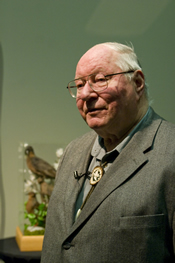UA Regents, museum honor ornithologist Henry Springer
UA Regents, museum honor ornithologist Henry Springer
Submitted by Kerynn Fisher
Phone: 907-474-6941
12/02/08

The University of Alaska Board of Regents and the University of Alaska Museum of the North honored longtime museum research associate Henry Springer today, dedicating the museum’s ornithology laboratory in his name.
Perhaps best known in Alaska’s engineering and construction circles, Springer had a long and successful career at the Alaska Department of Transportation and later served as member of the Alaska Legislature and as head of Associated General Contractors.
Springer’s lifelong passion, however, was the scientific study of birds. For more than 40 years, Springer has worked with staff from the museum’s ornithology department, generously donating his time and expertise as well as specimens to the bird collection. Museum bird curator Kevin Winker calls Springer "a classic 19th century naturalist" and considers Springer to be an expert on international permitting as well as an extremely talented taxidermist. His specimen donations have broadened both the geographic and taxonomic scope of the museum’s collection.
At the dedication ceremony, Springer donated four more specimens, mounted in a display case: a passenger pigeon, extinct since 1914; a Socorro dove, now extinct in the wild, a mourning dove and an eared dove.
"It’s almost impossible for a collection like ours to add historically important research material without contributions like Henry’s," Winker says. He notes that Springer’s most recent specimen donations will serve as tangible examples of wildlife management mistakes and successes. "The value to science and education is huge."
The museum’s bird collection is a relatively young collection, dating to the 1950s. However, it is one of the fastest-growing bird collections in the world and now ranks in the top 10 for bird tissue collections.


